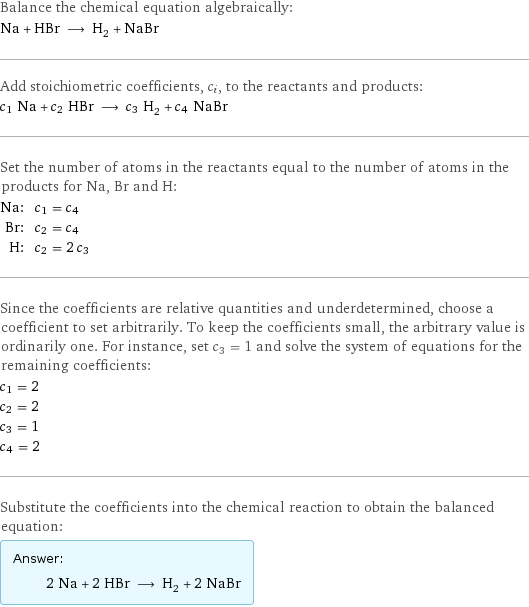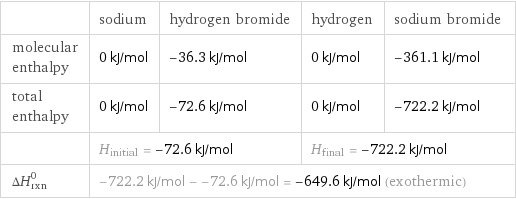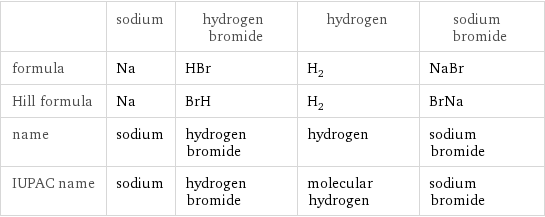Input interpretation

Na sodium + HBr hydrogen bromide ⟶ H_2 hydrogen + NaBr sodium bromide
Balanced equation

Balance the chemical equation algebraically: Na + HBr ⟶ H_2 + NaBr Add stoichiometric coefficients, c_i, to the reactants and products: c_1 Na + c_2 HBr ⟶ c_3 H_2 + c_4 NaBr Set the number of atoms in the reactants equal to the number of atoms in the products for Na, Br and H: Na: | c_1 = c_4 Br: | c_2 = c_4 H: | c_2 = 2 c_3 Since the coefficients are relative quantities and underdetermined, choose a coefficient to set arbitrarily. To keep the coefficients small, the arbitrary value is ordinarily one. For instance, set c_3 = 1 and solve the system of equations for the remaining coefficients: c_1 = 2 c_2 = 2 c_3 = 1 c_4 = 2 Substitute the coefficients into the chemical reaction to obtain the balanced equation: Answer: | | 2 Na + 2 HBr ⟶ H_2 + 2 NaBr
Structures

+ ⟶ +
Names

sodium + hydrogen bromide ⟶ hydrogen + sodium bromide
Reaction thermodynamics
Enthalpy

| sodium | hydrogen bromide | hydrogen | sodium bromide molecular enthalpy | 0 kJ/mol | -36.3 kJ/mol | 0 kJ/mol | -361.1 kJ/mol total enthalpy | 0 kJ/mol | -72.6 kJ/mol | 0 kJ/mol | -722.2 kJ/mol | H_initial = -72.6 kJ/mol | | H_final = -722.2 kJ/mol | ΔH_rxn^0 | -722.2 kJ/mol - -72.6 kJ/mol = -649.6 kJ/mol (exothermic) | | |
Entropy

| sodium | hydrogen bromide | hydrogen | sodium bromide molecular entropy | 51 J/(mol K) | 199 J/(mol K) | 115 J/(mol K) | 84 J/(mol K) total entropy | 102 J/(mol K) | 398 J/(mol K) | 115 J/(mol K) | 168 J/(mol K) | S_initial = 500 J/(mol K) | | S_final = 283 J/(mol K) | ΔS_rxn^0 | 283 J/(mol K) - 500 J/(mol K) = -217 J/(mol K) (exoentropic) | | |
Equilibrium constant
![Construct the equilibrium constant, K, expression for: Na + HBr ⟶ H_2 + NaBr Plan: • Balance the chemical equation. • Determine the stoichiometric numbers. • Assemble the activity expression for each chemical species. • Use the activity expressions to build the equilibrium constant expression. Write the balanced chemical equation: 2 Na + 2 HBr ⟶ H_2 + 2 NaBr Assign stoichiometric numbers, ν_i, using the stoichiometric coefficients, c_i, from the balanced chemical equation in the following manner: ν_i = -c_i for reactants and ν_i = c_i for products: chemical species | c_i | ν_i Na | 2 | -2 HBr | 2 | -2 H_2 | 1 | 1 NaBr | 2 | 2 Assemble the activity expressions accounting for the state of matter and ν_i: chemical species | c_i | ν_i | activity expression Na | 2 | -2 | ([Na])^(-2) HBr | 2 | -2 | ([HBr])^(-2) H_2 | 1 | 1 | [H2] NaBr | 2 | 2 | ([NaBr])^2 The equilibrium constant symbol in the concentration basis is: K_c Mulitply the activity expressions to arrive at the K_c expression: Answer: | | K_c = ([Na])^(-2) ([HBr])^(-2) [H2] ([NaBr])^2 = ([H2] ([NaBr])^2)/(([Na])^2 ([HBr])^2)](../image_source/0597a3f03f467818d323cea555716719.png)
Construct the equilibrium constant, K, expression for: Na + HBr ⟶ H_2 + NaBr Plan: • Balance the chemical equation. • Determine the stoichiometric numbers. • Assemble the activity expression for each chemical species. • Use the activity expressions to build the equilibrium constant expression. Write the balanced chemical equation: 2 Na + 2 HBr ⟶ H_2 + 2 NaBr Assign stoichiometric numbers, ν_i, using the stoichiometric coefficients, c_i, from the balanced chemical equation in the following manner: ν_i = -c_i for reactants and ν_i = c_i for products: chemical species | c_i | ν_i Na | 2 | -2 HBr | 2 | -2 H_2 | 1 | 1 NaBr | 2 | 2 Assemble the activity expressions accounting for the state of matter and ν_i: chemical species | c_i | ν_i | activity expression Na | 2 | -2 | ([Na])^(-2) HBr | 2 | -2 | ([HBr])^(-2) H_2 | 1 | 1 | [H2] NaBr | 2 | 2 | ([NaBr])^2 The equilibrium constant symbol in the concentration basis is: K_c Mulitply the activity expressions to arrive at the K_c expression: Answer: | | K_c = ([Na])^(-2) ([HBr])^(-2) [H2] ([NaBr])^2 = ([H2] ([NaBr])^2)/(([Na])^2 ([HBr])^2)
Rate of reaction
![Construct the rate of reaction expression for: Na + HBr ⟶ H_2 + NaBr Plan: • Balance the chemical equation. • Determine the stoichiometric numbers. • Assemble the rate term for each chemical species. • Write the rate of reaction expression. Write the balanced chemical equation: 2 Na + 2 HBr ⟶ H_2 + 2 NaBr Assign stoichiometric numbers, ν_i, using the stoichiometric coefficients, c_i, from the balanced chemical equation in the following manner: ν_i = -c_i for reactants and ν_i = c_i for products: chemical species | c_i | ν_i Na | 2 | -2 HBr | 2 | -2 H_2 | 1 | 1 NaBr | 2 | 2 The rate term for each chemical species, B_i, is 1/ν_i(Δ[B_i])/(Δt) where [B_i] is the amount concentration and t is time: chemical species | c_i | ν_i | rate term Na | 2 | -2 | -1/2 (Δ[Na])/(Δt) HBr | 2 | -2 | -1/2 (Δ[HBr])/(Δt) H_2 | 1 | 1 | (Δ[H2])/(Δt) NaBr | 2 | 2 | 1/2 (Δ[NaBr])/(Δt) (for infinitesimal rate of change, replace Δ with d) Set the rate terms equal to each other to arrive at the rate expression: Answer: | | rate = -1/2 (Δ[Na])/(Δt) = -1/2 (Δ[HBr])/(Δt) = (Δ[H2])/(Δt) = 1/2 (Δ[NaBr])/(Δt) (assuming constant volume and no accumulation of intermediates or side products)](../image_source/463ce9c4eef9defd3b93ee0d519b785f.png)
Construct the rate of reaction expression for: Na + HBr ⟶ H_2 + NaBr Plan: • Balance the chemical equation. • Determine the stoichiometric numbers. • Assemble the rate term for each chemical species. • Write the rate of reaction expression. Write the balanced chemical equation: 2 Na + 2 HBr ⟶ H_2 + 2 NaBr Assign stoichiometric numbers, ν_i, using the stoichiometric coefficients, c_i, from the balanced chemical equation in the following manner: ν_i = -c_i for reactants and ν_i = c_i for products: chemical species | c_i | ν_i Na | 2 | -2 HBr | 2 | -2 H_2 | 1 | 1 NaBr | 2 | 2 The rate term for each chemical species, B_i, is 1/ν_i(Δ[B_i])/(Δt) where [B_i] is the amount concentration and t is time: chemical species | c_i | ν_i | rate term Na | 2 | -2 | -1/2 (Δ[Na])/(Δt) HBr | 2 | -2 | -1/2 (Δ[HBr])/(Δt) H_2 | 1 | 1 | (Δ[H2])/(Δt) NaBr | 2 | 2 | 1/2 (Δ[NaBr])/(Δt) (for infinitesimal rate of change, replace Δ with d) Set the rate terms equal to each other to arrive at the rate expression: Answer: | | rate = -1/2 (Δ[Na])/(Δt) = -1/2 (Δ[HBr])/(Δt) = (Δ[H2])/(Δt) = 1/2 (Δ[NaBr])/(Δt) (assuming constant volume and no accumulation of intermediates or side products)
Chemical names and formulas

| sodium | hydrogen bromide | hydrogen | sodium bromide formula | Na | HBr | H_2 | NaBr Hill formula | Na | BrH | H_2 | BrNa name | sodium | hydrogen bromide | hydrogen | sodium bromide IUPAC name | sodium | hydrogen bromide | molecular hydrogen | sodium bromide
Substance properties

| sodium | hydrogen bromide | hydrogen | sodium bromide molar mass | 22.98976928 g/mol | 80.912 g/mol | 2.016 g/mol | 102.89 g/mol phase | solid (at STP) | gas (at STP) | gas (at STP) | solid (at STP) melting point | 97.8 °C | -86.8 °C | -259.2 °C | 755 °C boiling point | 883 °C | -66.38 °C | -252.8 °C | 1396 °C density | 0.968 g/cm^3 | 0.003307 g/cm^3 (at 25 °C) | 8.99×10^-5 g/cm^3 (at 0 °C) | 3.2 g/cm^3 solubility in water | decomposes | miscible | | soluble surface tension | | 0.0271 N/m | | dynamic viscosity | 1.413×10^-5 Pa s (at 527 °C) | 8.4×10^-4 Pa s (at -75 °C) | 8.9×10^-6 Pa s (at 25 °C) | odor | | | odorless |
Units
